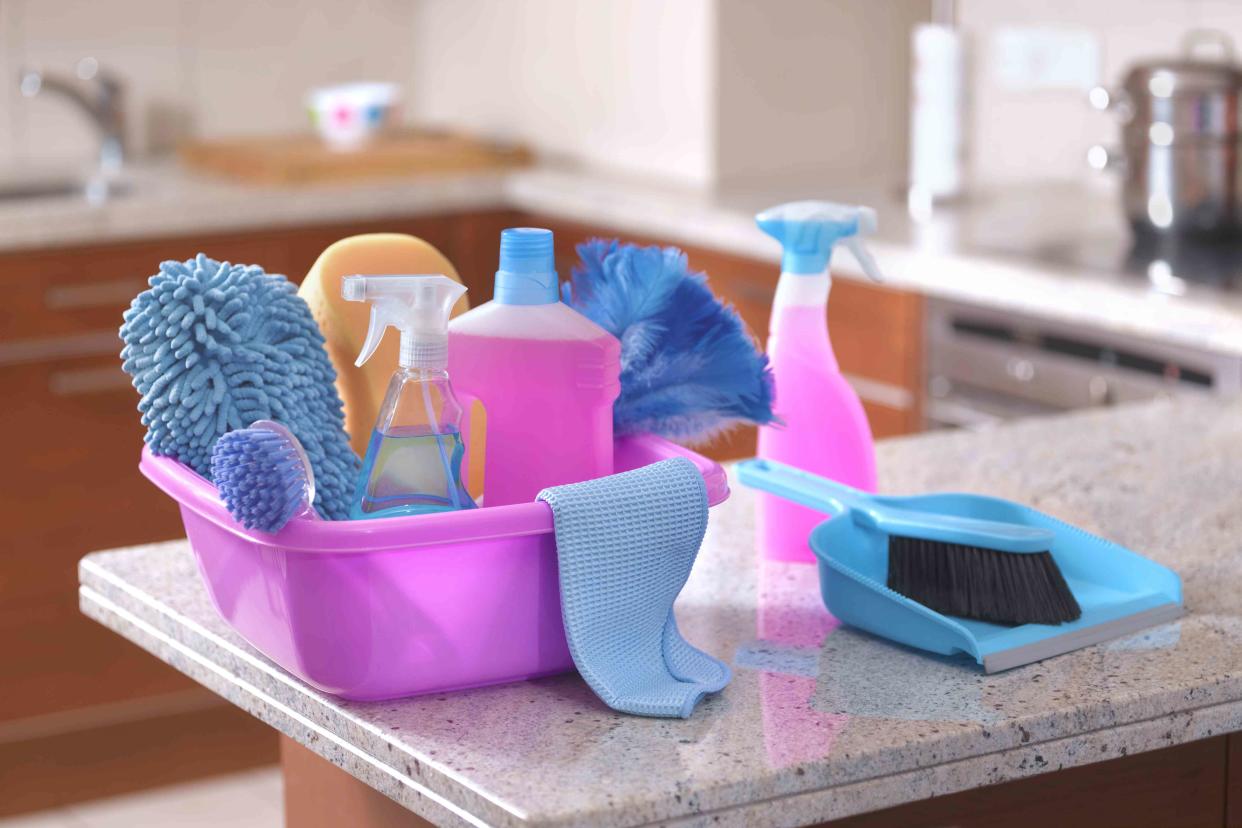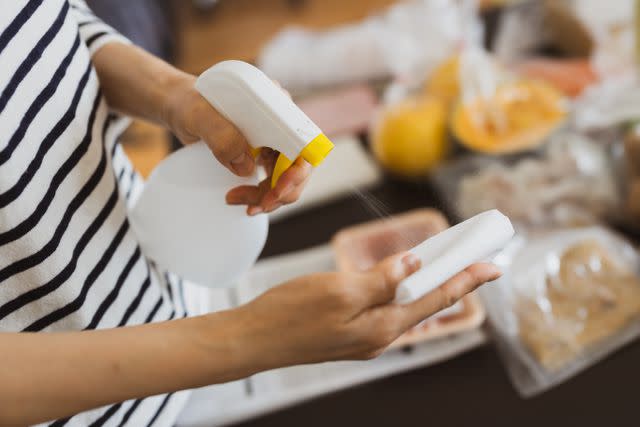Cleaning Products You Should Never Mix

Carol Yepes / Getty
When it’s time to clean, you may think that reaching for a variety of cleaning products is your best bet for a sparkling home. If you have a difficult area or lots of grime, more cleaning products may seem like it equates to a better and more efficient cleaning. But that’s not true, in fact it could cause delays and worse, be harmful to your health. “Cleaning products are specifically designed to safely and effectively work, clean, and perform the task by themselves,” explains Armeka Townsend, Zep Cleaning Expert & Senior Consumer Relations Representative.
Why You Shouldn’t Combine Cleaning Products
Before you start mixing cleaning products, think again. “Never mix any cleaning chemical products,” says Townsend. Cleaning products are made from different chemicals and mixing one cleaner with another could cause a bad science experiment in your home and possibly even release toxic chemicals. “Combining cleaning products can lead to the formation of noxious fumes that, in some cases, can cause serious medical harm or even death,” Kelly Johnson-Arbor, MD, FACEP, FUHM, FACMT, Medical Toxicologist, Co-Medical Director, and Interim Executive Director, National Capital Poison Center. “These chemical fumes are more likely to cause poisoning when cleaning products are used in enclosed spaces like bathrooms, where there is little ventilation.”

dowell / Getty
Before You Clean
Before reaching for cleaning products and applying them to surfaces, make sure to read the label and instructions. “Check the back of the labels for any warnings, and for how to use the product safely, if protective gear, such as gloves or goggles need to be used,” explains Tonya Harris, award-winning toxin expert and author of The Slightly Greener Method.
Products You Should Never Combine
Bleach And Rubbing Alcohol
An active ingredient in bleach is sodium hypochlorite, and chloroform is formed when it’s combined with alcohol. “Chloroform is a clear liquid with a pleasant odor,” explains Johnson-Arbor. And if it sounds familiar, ”that’s the stuff used to knock out and kidnap the victim in the James Bond movies!,” says Carol Mehas, Founder of arbOUR Products, natural cleaning products. You’ll want to avoid creating chloroform in your home since it can have harmful to fatal consequences. According to Johnson-Arbor, “Inhalation of chloroform vapors can cause fatigue, excessive sleepiness, and death.”
Bleach And Acidic Substances
Mixing vinegar or lemon juice with bleach can produce a chlorine gas, which is harmful. “Chlorine gas is a respiratory irritant and can cause coughing, breathing difficulties, burning sensations in the eyes, nose, and throat, as well as vomiting and chest pain,” says Townsend. “In high concentrations, exposure to chlorine gas can be fatal.”
Harris advises not to mix different cleaning agents in small spaces without windows or near one another. “White vinegar is a popular cleaning ingredient, and although on its own is typically harmless, using that as a toilet bowl cleaner and then using a bleach-based cleaner on and around the toilet, for example, could create harmful fumes when used that closely together,” explains Harris.
If you’re going to use bleach, Townsend recommends, “It’s best practice to use bleach on its own when cleaning rooms – and turn a fan on!”
Bleach And Ammonia
Bleach is known to be a good disinfectant but you don’t want to ever mix it with ammonia. Ammonia is a common ingredient in window cleaners. Combining these two products creates toxic vapors. “When these two chemicals combine, they produce a reaction that releases chloramine gas, which can cause respiratory issues, coughing, shortness of breath, chest pain, nausea, and even death in severe cases,” says Townsend.
Bleach And Drain Cleaner
If you have a clogged drain, the typical first step is to reach for a drain cleaner. “Drain cleaners can contain enzymes that dissolve clogs, or they may contain acidic or alkaline chemicals that break down debris found in drains,” says Johnson- Arbor.
Sometimes it takes a while for the drain cleaner to work its magic but if you're impatient, don’t pour bleach down the drain or you’ll create chlorine gas. “When chlorine combines with watery substances such as saliva or tears, hydrochloric acid and hypochlorous acids are formed,” says Johnson- Arbor. “These acids are very irritating and can cause burns and other corrosive injuries affecting the lungs and other tissues.”
Bleach is already a strong alkali with a makeup of a chlorine atom, and lye is an alkali made with a hydrogen atom, says Mehas. “Since they both accomplish the same result – that is, to break down organic matter stuck in your drain – to double up on the alkali is not worth the risk of creating Chlorine gas.”
Two Types Of Drain Cleaner
Pour a drain cleaner in a clogged pipe and it doesn't seem to be working so you think, why not try another drain cleaner? Don’t do it or you put yourself and family at risk for toxic fumes. “Since drain cleaners can contain different ingredients, including enzymes, acids, and bases, mixing different types of drain cleaners can also cause the formation of toxic gasses, such as chlorine,” says Johnson- Arbor. “Mixing acids and bases together can also sometimes generate large amounts of heat that can potentially cause severe burns.”
Vinegar And Hydrogen Peroxide
“When using vinegar and hydrogen peroxide separately, they can be quite effective but mixing them can lead to adverse effects,” explains Townsend.
Avoid combining these two products in one container because it can create peracetic acid. According to Townsend, “Peracetic acid can cause respiratory and eye irritation, as well as skin burns and damage to the lungs in higher concentrations.”
What To Do In An Emergency
If any issues occur after using a cleaning product, don’t hesitate to call Poison Control. “For questions about unwanted or unexpected signs or symptoms that occur after use of cleaning products, contact Poison Control for expert advice,” says Johnson- Arbor. “There are two ways to contact Poison Control: online at www.poison.org or by phone at 1-800-222-1222. Both options are free, confidential, and available 24 hours a day.”

Susumu Yoshioka / Getty
Safety Tips For Cleaning
Do not combine products. “Do not pour one cleaning product into another, or combine them to clean with, for example, don’t pour two cleaners into the same bottle hoping for more cleaning power,” explains Harris.
Read the label first. If you’re thinking about using different products together or in the vicinity, check the label first “Check the list of active ingredients to identify any potentially hazardous combinations, such as bleach, ammonia, or acids,” says Townsend. “If you're unsure about the compatibility of two products, avoid using them together.”
Follow the manufacturer's usage directions. “Read and follow the manufacturer's recommended usage instructions to ensure you are using the product correctly,” says Townsend. “This may include guidance on which surfaces the product is suitable for, how much to use, and any specific application methods.”
Be prepared. Before you use a product, read the label on what to do if the unexpected happens. “Familiarize yourself with the first aid and emergency procedures outlined on the label,” says Townsend. “In case of accidental exposure or ingestion, this information will be crucial.”
Store products safely away. Cleaning products are often kept under sinks so you want to make sure kids and pets can’t easily open a door or drawer. “Keep all cleaners out of the reach of children and pets, and make sure they are clearly labeled with the original label so you know exactly how to use the product safely,” says Harris.
Follow storage instructions. “Check the storage instructions so it can be stored safely, away from heat and light, etc., shares Harris. Townsend agrees, “Follow the recommended storage and disposal guidelines to prevent accidental mixing or spills, which can lead to dangerous chemical reactions.”
For more Southern Living news, make sure to sign up for our newsletter!
Read the original article on Southern Living.

